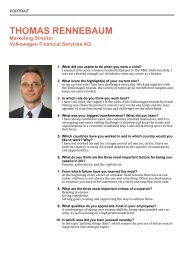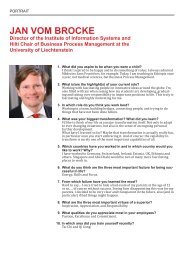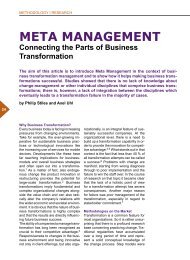Digital Enterprise Transformation - 360° Journal
Digital Enterprise Transformation - 360° Journal
Digital Enterprise Transformation - 360° Journal
- No tags were found...
You also want an ePaper? Increase the reach of your titles
YUMPU automatically turns print PDFs into web optimized ePapers that Google loves.
METHODOLOGY | RESEARCHBeschriftung rechte vertikale Achse wegAxel RS 17.09.20121980-90‘s 2000 2005 2012Local integrationClient-ServerArchitectureGlobalHarmonizationERP roll-outBusiness ProcessManagement (BPM)and Service OrientedArchitecture (SOA)Next Generation IT,becoming a <strong>Digital</strong><strong>Enterprise</strong>Fig. 4: Evolutionof IT architecturestowards a<strong>Digital</strong> <strong>Enterprise</strong>(source: SAP)35opportunities and possible threats. Thisincludes new technologies, managementtrends, industry drivers, and whatthe competitors do. A retrospective viewover the last decades shows that the ITstrategies chosen by companies seemto have followed three general strategictendencies (see fig. 4).In the 1980s and 1990s, the main priorityfor companies was to integrate businessprocesses, for example by implementing<strong>Enterprise</strong> Resource Planning (ERP)software for finance and controlling, logistics,production, and human resources.Achieving this integration by implementingintegrated systems was hugelybeneficial. The projects were mostly localimplementations, though, followingthe decentralized make-up of companieswhich allowed their international subsidiariesto operate more or less independently.As globalization increased, the attentionshifted to efficiency improvements. Thedecentralized structures were suddenlyperceived as “road blockers” and as obstructingcontrol and reporting processesand as limiting transparency. Thus,companies started developing strategieswhich put emphasis on centralization.For IT, this meant developing consolida-tion strategies, i.e. to achieve global harmonizationof processes, data, and systems.From a technological perspective,the Internet offered an excellent basefor the global harmonization projects,but they turned out to be complex, timeconsumingand they cost a lot of money.The resulting IT systems on the one handcould ensure global transparency and acommon quality standard in all countries.On the other hand, it was more difficult totake into account heterogeneous marketrequirements and different levels of marketand organization maturity. Now everyfurther system enhancement endeavorhad to follow global processes and wastherefore somewhat inflexible and cumbersome.From a business perspective,IT was increasingly perceived as impedingthe necessary adaptation to marketdynamics and, consequently, as jeopardizingthe success of a business. This resultedin an ever-dwindling acceptanceof many IT departments.In around 2005, a new paradigm emergedwhich promised to be the savior in the dilemmaof global standardization versusdynamic adaptation: “service-orientedarchitecture” (SOA). Using predefinedWeb services, this architecture aimed atachieving the necessary flexibility and© 2012 SAP AG. All rights reserved. 4













